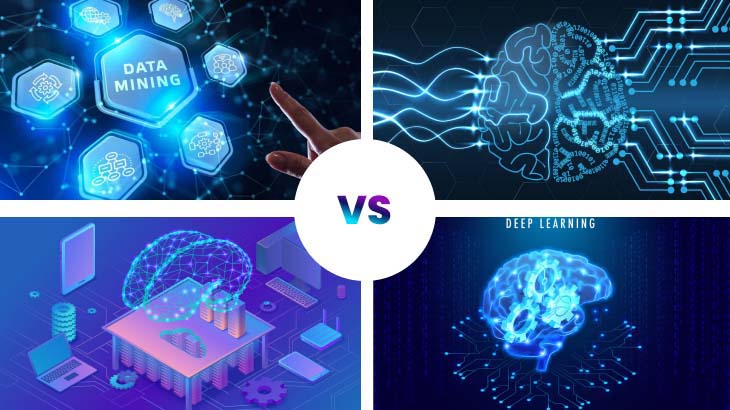As data becomes the prime mover in the modern world, pretty much everyone has floundered upon such terms as machine learning, artificial intelligence, deep learning, and data mining at some point. Data becomes the most critical factor behind machine learning, data mining, data science, and deep learning.
Data analysis and insights are very crucial in today’s world. Hence investing time, effort, and costs in these analysis techniques forms a critical decision for businesses. Data Mining, Machine Learning, Deep Learning, and Artificial Intelligence are fascinating concepts with so much gravity. However, the real question is Data Mining Vs Machine Learning Vs Artificial Intelligence Vs Deep Learning.
Data Mining and Machine learning are areas inspired by each other. Though they have many things in common, they have different ends. Humans perform data mining on specific data sets to find exciting patterns between the items in a data set. Data mining uses techniques developed by machine learning to predict the outcome.
Data Mining
What is Data Mining?
Data Mining is a process companies use to turn raw data into useful information. By using software to look for patterns in large batches of data, businesses can learn more about their customers to develop more effective marketing strategies, increase sales and decrease costs. Data mining depends on effective data collection, warehousing, and computer processing.
Advantages of Data Mining
1. Predictions are gathered automatically based on trend and behaviour analysis.
2. Predictions are formulated based on likely outcomes.
3. Decision-oriented information.
4. Centres around large data sets and databases for analysis.
Machine Learning
What is Machine Learning?
Machine learning is a modern innovation that has enhanced many industrial and professional processes and our daily lives. It is a subset of artificial intelligence (AI), which focuses on using statistical techniques to build intelligent computer systems to learn from available databases.
With machine learning, computer systems can take all the customer data and utilize it. It operates on what has been programmed while adjusting to new conditions or changes. Algorithms adapt to data, developing behaviours that were not programmed in advance.
Types of machine learning
Machine learning involves showing a large volume of data to a machine to learn, make predictions, find patterns, or classify data. The three machine learning types are supervised, unsupervised, and reinforcement learning.
1. Supervised learning
Gartner, a business consulting firm, predicts that supervised learning will remain the most utilized machine learning among enterprise information technology leaders in 2022. This type of machine learning feeds historical input and output data in machine learning algorithms, with processing between each input/output pair that allows the algorithm to shift the model to create outputs as closely aligned with the desired result.
Standard algorithms used during supervised learning include neural networks, decision trees, linear regression, and support vector machines.
2. Unsupervised learning
While supervised learning requires users to help the machine, unsupervised learning does not use the same labelled training sets and data. Instead, the machine looks for less apparent patterns in the data. This machine learning type is beneficial when you identify patterns and use data to make decisions.
Standard algorithms used in unsupervised learning include Hidden Markov models, k-means, hierarchical clustering, and Gaussian mixture models. Using the example from supervised learning, let us say you did not know which customers did or did not default on loans. Instead, you would provide the machine with borrower information, and it would look for patterns between borrowers before grouping them into several clusters.
3. Reinforcement learning
Reinforcement learning is the closest machine learning type to how humans learn. The algorithm or agent learns by interacting with its environment and getting a positive or negative reward. Standard algorithms include temporal difference, deep adversarial networks, and Q-learning.
Going back to the bank loan customer example, you might use a reinforcement learning algorithm to look at customer information. If the algorithm classifies them as high-risk and they default, the algorithm gets a positive reward. If they do not default, the algorithm gets a negative reward. In the end, both instances help the machine learn by better understanding the problem and environment.
Advantages of Machine Learning
1. An application of artificial intelligence.
2. Software applications to make accurate predictions of the outcomes.
3. Centres around the development of computer programs.
4. Empower computers to learn automatically without human intervention.
Artificial Intelligence
What is Artificial Intelligence?
Artificial intelligence is the simulation of human intelligence processes by machines, especially computer systems. Specific applications of AI include expert systems, natural language processing, speech recognition and machine vision.
As the hype around AI has accelerated, vendors have been scrambling to promote how their products and services use AI. They often refer to AI as one component of AI, such as machine learning. AI requires a foundation of specialized hardware and software for writing and training machine learning algorithms. No programming language is synonymous with AI, but a few, including Python, R and Java, are popular.
Advantages of Artificial Intelligence
1. Potential to deal with large datasets
2. Higher speed
3. Make innovations, design, and develop higher-yielding products and services.
Deep Learning
What is Deep learning?
Deep learning is a subset of machine learning, which is a subset of artificial intelligence. Deep learning algorithms attempt to draw similar conclusions as humans would by continually analyzing data with a given logical structure. To achieve this, deep learning uses multi-layered structures of algorithms called neural networks.
Deep learning algorithms attempt to draw similar conclusions as humans would by continually analyzing data with a given logical structure. To achieve this, deep learning uses a multi-layered structure of algorithms called neural networks.
The neural network design is based on the structure of the human brain. Just as we use our brains to identify patterns and classify different types of information, we can teach neural networks to perform the same tasks on data. The individual layers of neural networks can also be thought of as a sort of filter that works from gross to subtle, which increases the likelihood of detecting and outputting a correct result. The human brain works similarly. Whenever we receive new information, the brain tries to compare it with known objects. Deep neural networks also use the same concept.
Advantages of Deep Learning
1. Process and inspect the extensive data available via systematic programming, disciplines, and codes to share cognizance and inference.
2. Develop patterns and trends
Applications of Deep Learning
1. Automatic Handwriting generation
2. Self-driving cars
3. Language Translation
4. Virtual assistants
5. Image and fingerprint recognition functions
6. Source platforms with customer recommendations
7. Banking apps
8. Medical research tool
9. Business trends and outcomes
As data is proliferating, these methods should be fast enough to incorporate the new data sets and predict helpful analysis. Machine learning can help us quickly process the data and automatically deliver quicker results in the form of models.
Data mining techniques produce patterns and trends from historical data to predict future outcomes. These outcomes are in the form of graphs, charts, etc. Statistical analysis forms an integral part of data analysis and will grow higher shortly.
These technologies will immensely grow in the future as business processes improve. These, in turn, will also help businesses automate the manual process, increase sales and profits, and help in customer retention.

















Post Comments